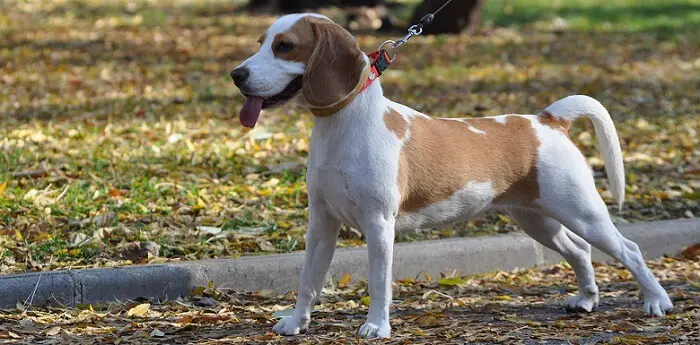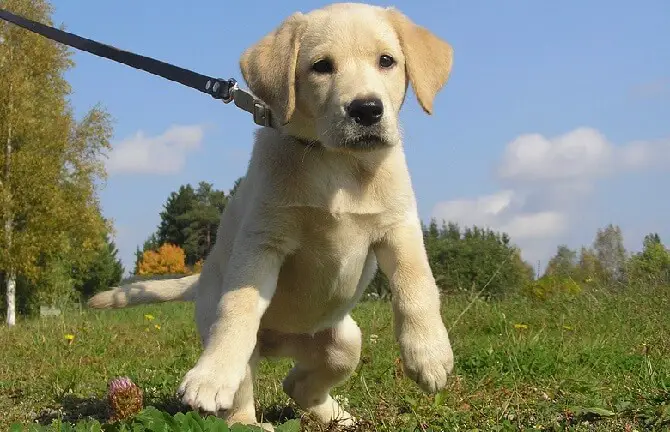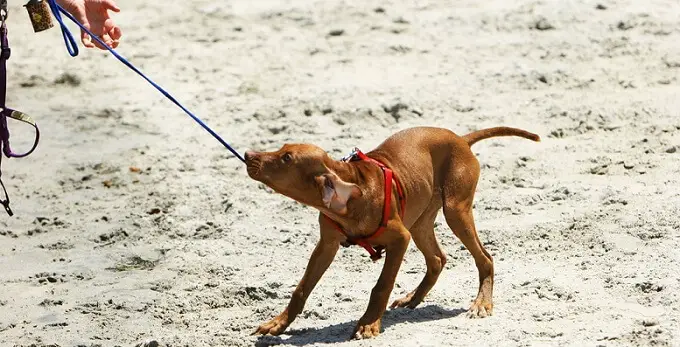Table of Contents
*This post may contain affiliate links. As an Amazon Associate we earn from qualifying purchases.
Bringing home a new dog is an exciting new journey for any pet parent. From the most experienced to new dog owners, we all could use a refresher in proper leash training from time to time. The guide below will give you seven steps to follow when leash training your new best friend. Keep in mind that learning how to leash train a dog starts before you even go outside for the first time.
Learning how to leash train a dog will require consistent patience on your part. Don’t get frustrated with your dog. Prepare to take frequent breaks during this process and don’t expect perfection overnight. If you adopted your dog from a shelter, even if they are still young, they may have some anxious behaviors that will need to be worked through.

Step 1: Slowly Introduce the Leash
This first step in discovering how to leash train a dog starts inside the house. Let your dog wear their collar or harness around the house for a few days, while giving them lots of praise and treats. You can then add in the leash factor, still while in the house. Don’t forget the positive reinforcements!
This will help your puppy associate the leash with a fun bonding experience with you. If you are raising your puppy with anyone else in the house, be sure to include them in this process as well. This is an important part of teaching everyone in the home how to leash train a dog so that there is consistent leash behavior no matter who is walking him.
Step 2: Use a Signal
Every dog trainer has a variety of signals that they like to use for different purposes. Signals are an important part of thinking through how to leash train a dog. Some use clickers or verbal cues like a word or a discrete sound. If you are new to using these cues, there are some basics to it.
Start in a quiet room with your puppy on their leash and make the sound or click the clicker. As soon as your puppy acknowledges you, they should be rewarded. It won’t take long for your puppy to come over to you on their leash to get their reward.

Step 3: Back Away
Putting distance between you and your pup builds mutual trust, a vital part of how to leash train a dog. Slowly back away from your puppy while they are coming toward you for their treat and continue to reward them for following you.
When you leash train your puppy, you should repeat this exercise until your little fellow comes right to you from anywhere in the room when you give your signal. You should keep these exercises short and wait until your puppy is full of energy to start. A tired dog will not respond well to training.
Step 4: Move Outside
Once you have practiced inside for a while, your puppy is ready to take their skills outdoors. This will be an over-stimulating experience for a young dog at first. Puppies will be distracted by the sights, sounds, and smells of everything around them. With a little patience, you will be an expert on how to leash train a dog outside.
Keep the first few walks very short with your dog. Every time he pulls or looks distracted, give it your signal while moving a few steps forward. Reward the dog when he follows you. This exercise should be done with anyone in your home who will be walking your dog.
Step 5: Address Pulling
If your dog pulls, you must address this behavior right away. When your dog begins pulling in the opposite direction or won’t keep pace with you, stop moving and stand very still.
Do not move again until your dog comes back to you. Harnesses are recommended over collars for most dogs for this reason. If you have a dog who is predisposed to pulling, you may consider a special harness that hooks in the front or even a head harness to help curb this behavior.

Step 6: Prepare for Problems
While walking your dog, it is almost a guarantee that they will see something that will catch their attention and cause them to plunge suddenly. This happens regardless of the age at which you begin leash training, especially among working dog breeds. Have treats on hand for redirecting this behavior and rewarding desired behaviors right away.
If your dog tends to plunge at moving vehicles, bring someone on walks with you that will distract your dog each time a car goes by until they are desensitized to the movement of the cars.
The same is true for dogs that bark or lunge at passing people or other dogs. Be mindful of your dog’s behaviors and plan your walks accordingly. You want to correct these issues while still keeping everyone safe.
Step 7: Reteach and Reinforce
A sudden move, a change in your household, or even a new baby may trigger old behaviors in your dog as he grows. Be mindful of stressors in your dog’s environment. These things could cause your dog to do things they haven’t struggled with since they were a puppy. If this is the case, go back to the basics of how to leash train a dog. Consistency is key if this problem should arise.
Drawing to a Close
Figuring out how to leash train a dog doesn’t have to be stressful. Following the steps outlined above will ensure your dog is well-mannered on walks regardless of who is walking them or where they are.
If you have successfully learned how to leash train your dog using our tips, let us know! Leave us a comment with how things went and any problems you had along the way. We would love to know what strategies worked best and what new tips you may have for our readers.

